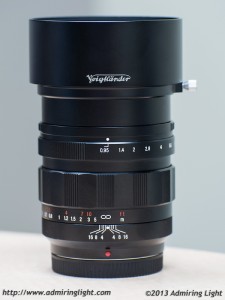Voigtländer is the oldest name in photography. The original Voigtländer optical company was founded in 1756 and has been producing groundbreaking photography equipment since. They created the fastest optical lens in the world in 1840, the original Petzval lens, which was a screaming fast f/3.7. Ok, screaming fast for 1840. They also created the first all-metal daguerreotype camera in 1841. That legacy of solid metal build and ultra-fast optics is realized today in the lineup of ultra-fast lenses for the Micro 4/3 system.

Today, the Voigtländer name is owned by Cosina in Japan, but they continue the legacy by producing outstanding optics for a range of SLRs, rangefinders and now mirrorless cameras. The lens we’re looking at today completes the trinity of ultra-fast primes for the Micro 4/3 mount. In 2010, Voigtländer made waves by introducing the 25mm f/0.95 Nokton. They followed that by creating a 35mm equivalent lens in the 17.5mm f/0.95 Nokton (reviewed here). Now, in 2013, they complete the trinity with a portrait length lens while maintaining that ultra-fast f/0.95 aperture in the Nokton 42.5mm f/0.95.
The 42.5mm f/0.95 has a field of view equivalent to an 85mm lens on a full frame camera, and so is perfectly suited to a range of applications, though with a fast aperture in this focal length, a primary use for this lens is available light portraiture. With an aperture of f/0.95, the Nokton 42.5mm is nearly two full stops faster than the Olympus 45mm f/1.8 for Micro 4/3 and gives you the ability for shallow depth of field usually reserved for larger format cameras. Enough talk, let’s dive in!
If you’re not familiar with my reviews, I review from a real world shooting perspective. You won’t find lens charts or resolution numbers here. There are plenty of other sites that cover those. I review products on how they act for me as a photographic tool in real-world shooting.

Around the Lens: Build Quality and Handling
Like the other f/0.95 Noktons, the 42.5mm f/0.95 is an extremely solidly built lens. It’s crafted entirely of metal and glass and is quite substantial in the hand. The lens is significantly larger than something like the Olympus 45mm f/1.8, as expected for such an extreme aperture, but even when seeing the size, the thing that surprises is the weight. This is a VERY dense lens, and feels far heavier than it looks. I’d highly recommend using this lens with a camera that has a relatively substantial hand grip, simply because it is rather front heavy. The lens weighs in at a hefty 1.25 pounds. Indeed, the Nokton 42.5mm f/0.95 is the heaviest lens currently made by a major manufacturer specifically for Micro 4/3.

The lens comes with a nice metal hood and a hood mounting ring that screws into the filter threads. If you don’t want to use the hood, you can leave this mounting ring off. If you plan on using the hood, screw the mounting ring on, and then the hood mounts to the ring via thumbscrew. The hood is also reversible for storage. Nice!
The lens has three rings: the broad scalloped manual focus ring, the aperture control ring, and a third ring that is spring-loaded. This top ring can be pulled down and rotated 180 degrees. When this is switched, the white aperture dot is now a yellow aperture dot, and the click-stops for f-stops are removed, allowing for continuous (and silent) aperture control from f/0.95 to f/16. This is quite useful for video use.
The manual focus ring is well damped and silky smooth to operate, while the aperture ring has nice solid detents every half stop. The aperture diaphragm is a 10 bladed design, which allows for generally round highlights throughout the aperture range. The lens is a joy to focus and feels wonderful in the hand. Of course, like all the Voigtländer lenses for Micro 4/3, the 42.5mm f/0.95 is an all-manual lens. You must set your aperture manually and then manually focus. Luckily, with the ability to magnify parts of the scene on most all Micro 4/3 cameras, manual focus is very accurate to use and can even be quick once you’ve had some practice.
One very unusual feature of the 42.5mm f/0.95 is its extremely close focus ability. Most 85mm lenses on full frame cameras have minimum focus distances in the 0.85m to 1m range. This is close enough to get a solid head and shoulders portrait of an adult, but not much closer. The Olympus 45mm f/1.8 features relatively close focus ability for a portrait lens, at 0.5m. The Voigtländer 42.5mm on the other hand, can focus all the way to 0.23m, which is extremely close, and allows for 1:4 magnification. Because of the smaller sensor of Micro 4/3, this actually covers the same area as a 1:2 macro lens on a full frame camera. With the ultra-wide f/0.95 aperture, you can create some very unique photographs with this lens that simply aren’t possible with anything else.





Leave a Reply